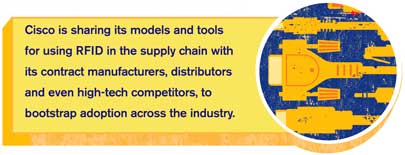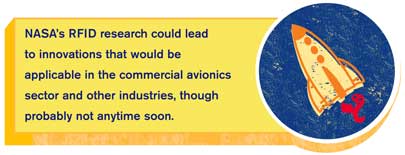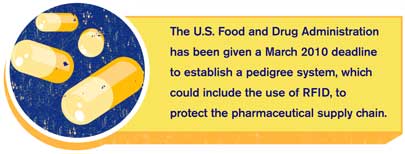FID Journal‘s Watch List, intended to help you assess the future of radio frequency identification. This week, we’ll focus on the companies and organizations to watch; we profiled the people last week, and we’ll cover the technologies next week. Overall, we think there are many exciting developments on the horizon, so stay tuned.
By Jennifer Zaino
Dec. 1, 2008—Radio frequency identification is at a crossroads. During the past six years, it’s gone from an obscure technology used by a handful of companies to a technology that is more widely understood and is being adopted in a broad range of business, government and consumer applications. The advancement of RFID can be attributed to the forward-thinking people who recognized its potential, the companies and organizations that boldly tested and implemented it, and the technology developments that made it smarter, as well as easier and less costly to deploy.
But RFID has not reached the level of adoption many envisioned, particularly in the global supply chain. As businesses plan for 2009 and 2010, and consider whether to invest in RFID or other technologies, the looming question is: Will RFID adoption accelerate across industries, or will it forever remain a niche technology delivering value in only a few applications?
That question can’t be answered today; it will only be answered over time. To help you see the writing on the wall more clearly, RFID Journal‘s editors surveyed the RFID landscape to identify the people, the companies and organizations, and the technological innovations that are most likely to influence adoption, either positively or negatively. On the following pages, you’ll find our Watch List to help you assess the future of RFID. Overall, we think there are many exciting developments on the horizon, so stay tuned.
Alien Technology
RFID tag and reader maker Alien Technology has long been a bellwether of the RFID industry, so there was a lot of interest when it filed for an initial public offering in 2006. When Alien pulled out of that IPO, some speculated about its survival. The company has proved those concerns unjustified, completing a $38 million round of funding in October. To date, it has raised $329 million.
What’s behind continued investor interest? Consider that in 2008, Alien will have doubled its 2007 tag volumes, and CEO George Everhart projects the company will double its 2008 volumes in 2009. While still a major supplier to consumer packaged-goods companies meeting retailer tagging mandates, Alien has expanded its business to serve end users in other industries as well. Opportunities in closed-loop solutions are growing by leaps and bounds for tracking everything from legal briefs to IT equipment and even apparel for manufacturers that deliver to their own branded outlets, Everhart says. “These solutions now seem to be implemented beyond the pilot phase by companies that did ROI studies and determined they can gain benefits from what RFID has to offer,” he adds.
Investor interest is also piqued by the opportunity to back a company that can innovate to meet emerging demands. In April, Alien announced the Higgs-3 integrated circuit, which builds in authentication and expanded user memory features designed for a range of applications—from airline baggage tracking to electronic pedigrees for pharmaceuticals.
If, as Everhart says, this last round of funding will make Alien “self-sustaining,” it would be a good sign that RFID adoption is progressing rapidly.
Boeing
In 2005, Boeing announced a bold RFID initiative for its 787 Dreamliner family of commercial aircraft: Seven hundred part types would have to be tagged by suppliers before they were shipped to the aircraft maker. It was Boeing‘s next step into RFID, after having used the technology in closed-loop manufacturing automation and asset-management applications in its facilities.
But Boeing encountered problems as it attempted to move RFID into its supply chain. Things are finally looking up, says Ken Porad, program manager for the Automated Identification Program at Boeing Commercial Airplanes Group. He expects to be able to demonstrate RFID’s maturity to high-level executives by year’s end. “This has been a long-term initiative,” Porad says. “We’ve been working for multiple years, and we’re getting close to deploying.”
Porad’s optimism is based on solid developments. Intelleflex’s passive RFID tags—with the extended user memory needed for parts tracking—are now in production. RFID testing facilities have begun testing tags to the AS5678 standard set by the Society of Automotive Engineers (and agreed to by the Federal Aviation Administration), which indicates they are ready to be put on an airplane. And the FAA in September released an advisory circular that provides guidelines RFID vendors can use to test and document that their parts and systems are aircraft-ready.
Porad hopes to begin testing the use of RFID-tagged parts in Boeing’s production system by early next year. The company is currently working with technology providers and parts suppliers to define the terms of such a pilot and the criteria for its success.
Looking forward, Boeing’s plans call for the initial deployment to affect at least its top 20 suppliers, and they, in turn, could ask their suppliers to RFID-tag parts. Airbus, Boeing’s main rival, also is extending its RFID implementations and pilots from internal operations to its global supply chain. This all bodes well for RFID’s adoption in the aerospace industry.
Cisco
While many companies guard information about their RFID deployments to maintain a competitive advantage, Cisco is sharing its models and tools for using RFID in the supply chain with its contract manufacturers, distributors and even high-tech competitors. Why? The networking solutions provider hopes to bootstrap adoption across the industry, in order to reduce its own manufacturing costs and cycle times. As more parties along the value chain adopt RFID, contract manufacturers can realize new efficiencies and savings, and pass on the lower costs of doing business that RFID can engender.
In one Cisco pilot with technology distributor Ingram Micro to gauge RFID’s impact on shipping and receiving operations, the results showed that about 62 percent of the benefits in improved operations accrued to Ingram Micro. “We are OK with that because we want to have a healthy partner ecosystem,” says Waseem Sheikh, director and group leader of the Cisco Internet Business Solutions Group‘s supply-chain management practice.
But Cisco has to make the case compelling for its contract manufacturers, which operate on razor-thin margins. Cisco accounts for no more than 25 percent of the revenue of each of its contract manufacturing partners, so those partners have to see value in RFID adoption with other customers, such as IBM, Intel and Xerox—and so do those customers.
It’s no sure thing that others will follow where Cisco wants to lead. “We expose our concepts to everyone, but we can’t force adoption,” Sheikh says. “It depends on their willingness and their own financial and operational situation to make a decision about whether they would adopt or not.”
DHL
Many companies in the transportation and logistics industry recognize the power of RFID to provide visibility into cargo movements around the world, but DHL has emerged as a clear leader. Consider just a few of the logistics provider’s recent initiatives in the RFID arena: DHL is working with Metro Group to track shipments to 89 of the German retailer’s stores in France. The company is participating in GS1’s RFID pilot program that’s tracking cargo containers from Hong Kong to Japan in real time, to demonstrate the value of the Electronic Product Code Information Services (EPCIS) standard. And last year, it won the first RFID Journal Award for Best Use of RFID in a Service for its pilot project that used RFID to monitor temperature-sensitive pharmaceutical products during transport, a solution it has since publicly launched (see A Prescription for Spoiled Drugs).
As DHL takes a three-pronged approach to RFID—forming strong partnerships with both companies and industry associations, and launching its own internal ventures—the logistics provider is spreading its roots, and RFID adoption, to other industries.
EPCglobal
EPCglobal has been working hard these past few years to promote the use of Electronic Product Code technology to increase visibility and efficiency throughout the supply chain, as well as to improve the flow of information between companies and their key trading partners. To further these goals, EPCglobal has developed hardware and data-sharing standards, providing greater efficiencies and lower costs. But EPC RFID adoption has not lived up to the original hype and predictions that the technology would revolutionize supply chains overnight.
That’s led some to wonder whether EPCglobal is failing to sell companies on the concept of using EPC RFID to manage their supply chains. Not so, says Ian Robertson, global development director and Asia Pacific regional director for EPCglobal. “Adoption is proceeding at a healthy rather than a frantic pace,” Robertson says. “When you change supply chains on the ground, the best way to change them is carefully.”
EPCglobal’s challenge now is to help companies understand that it’s what they do with the data generated by EPC RFID that leads to competitive advantage. To disseminate that information, EPCglobal is establishing instruction and support centers worldwide, and holding education seminars at RFID events. Much of the focus will be on the EPCIS standard, which enables the exchange of information to facilitate business in the global supply chain.
Robertson believes the message will resonate and build buy-in with business leaders. If it does, it could create the impetus for widespread adoption of EPC RFID technology.
European Commission
The European Commission, the executive branch of the European Union that proposes legislation and implements decisions, earlier this year released a draft of its guidelines that addressed RFID and consumer privacy concerns. It recommended, among other things, that companies planning to employ RFID should attach a symbol or sign to the tagged goods to alert customers to the presence of RFID, and that retailers selling tagged items must be able to deactivate the tags at point-of-sale stations.
Most stakeholders—including RFID vendors, end users, analysts and privacy groups—agree that some of the proposed privacy recommendations are critical to addressing lingering unease in order to drive consumer acceptance. By letting consumers know a product contains an RFID tag, and by communicating to them the benefits the technology could bring to their shopping experience, shoppers will be more accepting of RFID usage.
But some are concerned that the EC’s recommendations go too far and will cool RFID adoption in the European retail channel, without actually enhancing consumer privacy. The few companies that are RFID-tagging items typically put the tags on packaging or hangtags, so they’re discarded when shoppers get home. The EC says that even if only 0.1 percent of your product is tagged, European retailers must outfit every checkout stand with an RFID reader to kill the tag if the consumer requests it. That could add up to tens of thousands of euros and an unnecessary burden on retailers.
As we go to press, the EC is expected to issue a recommendation to member states about initial measures on addressing privacy, data protection and information security when implementing RFID technology.
Hewlett-Packard
Hewlett-Packard Brazil broke new ground in 2006 when it began RFID-tagging individual printers in its manufacturing lines and distribution center, and for warranty repair service. The company says it’s been able to improve manufacturing processes, reduce printer inventory in the supply chain, move closer to perfect order fulfillment and speed up its repair service. (HP won the first RFID Journal Award for Best RFID Implementation—see Keeping Tabs on Printers).
But HP is holding off on expanding item-level tagging for now due to privacy concerns, a lack of external mandates to move forward, and the need to get consensus around defining item-level tagging to mean putting the tag on the product, not the box that holds it. Still, the lessons learned in HP’s Brazil deployment about the power of RFID data for improving operations are bearing fruit in its North American operations.
HP is partnering with an undisclosed retailer to track pallets of goods—from the retail distribution center to the store’s receiving area and sales floor—to manage in-store promotions. “Promotions have a very short life,” says Greg Edds, HP’s worldwide RFID program lead. “Now we have true, actionable data to work with our retail partner to help them maximize the execution of those promotions.”
Success in that pilot could motivate other consumer electronics manufacturers to team with retailers to use RFID to improve in-store promotions.
NASA
NASA has conducted RFID pilots to track assets, such as crew-member uniforms for manned space flights. The agency also has sent containers bearing different RFID tags to the International Space Station, to ascertain how the commercial tags would survive when exposed to conditions in space. And NASA researchers are studying whether RFID could remotely and continually interrogate hundreds of thousands of sensors, to monitor the health of spacecraft components on explorations of the solar system.
But RFID’s use in these areas is by no means assured. “Inventory control is a logical, straightforward step, and you can get there from here; going on these other steps is a much further-out notion,” says Norman Lay, supervisor of the signal processing research group in the Communications Architecture and Research Section of NASA’s Jet Propulsion Laboratory (JPL) at the California Institute of Technology. JPL researchers, for instance, have been studying whether RFID signals would interfere with scientific equipment.
NASA’s RFID research could lead to innovations that would be applicable in the commercial avionics sector and other industries, though probably not anytime soon. “We’re still a ways away from the technology transfer,” Lay says. “Where we view RFID and its promise—it’s not 2009, probably.”
U.S. Food and Drug Administration
There’s consensus among stakeholders in the worldwide pharmaceuticals industry—governments, drug manufacturers and distributors, and pharmacies—that something has to be done to stem the flow of counterfeit drugs in the supply chain. But that’s where the consensus ends. Different countries—and various companies and organizations within each country—have their own ideas about what regulations and technologies can best solve the problem.
In the United States, some of these issues could soon be settled. The U.S. Food and Drug Administration has been given a March 2010 deadline to establish a pedigree system to protect the pharmaceutical supply chain. The FDA has often said that “RFID has promise in this area and use and potential for tracking and tracing for e-pedigree,” says Ilisa Bernstein, FDA director of pharmacy affairs. But earlier this year, the FDA accepted public comments about technology and identification standards to track prescription drugs, as well as comments about RFID as a practical identification and authentication tool. Having ended its period for requesting public input this past spring, the FDA is currently reviewing the results and can’t comment on them.
A lot is riding on the FDA’s decision—first and foremost, whether it identifies RFID as a technology to create electronic pedigrees, and, if so, whether it recommends high-frequency or ultrahigh-frequency RFID. Then there are the complicated issues surrounding compliance with and enforcement of a federal mandate—not only among individual companies but also with the states. “The FDA’s authority is solely over federal requirements,” Bernstein says. “We have said that a uniform pedigree in the U.S. would be ideal so there is the same requirement for all 50 states, but Congress would have to address that.”
Of course, the FDA has no jurisdiction outside the United States, but it’s a sure bet that the rest of the pharmaceuticals world also is awaiting its decision.
Wal-Mart
The world’s largest retailer is widely recognized for establishing the use of EPC standards to track goods in the supply chain with radio frequency identification. Wal-Mart has deployed the technology in 1,300 of its 4,100 domestic stores, but recently the retailer has been quiet about its plans, which has led to rumors of disorganization in the company’s rollout.
“Wal-Mart has gone into a period where they’re creating use cases for RFID so that they can determine the technology’s value,” says John Fontanella, supply-chain analyst for AMR Research. “Wal-Mart still remains committed to RFID, but it’s stepping back a moment and examining the technology’s value and its effect on business processes.”
Wal-Mart ran a category trial in late 2007 in which all cases of air fresheners were tagged and tracked. The result was that EPC RFID, combined with existing business practices, improved perpetual inventory, resulting in increased sales across the board. Wal-Mart is now expanding that trial, working with some of its top suppliers that have been tagging since 2005 to track all cases in particular categories. If the study shows that sales rose across the board, Wal-Mart could use the results to encourage more suppliers to tag more cases, leading to an increase in the use of EPC RFID technology within the supply chain.
Additional Stories
• RFID Journal’s Watch List: People to Watch
• RFID Journal’s Watch List: Technologies to Watch
What do you think the future holds for RFID adoption—and who and what is on your watch list? We’d like to know. Share your thoughts and opinions by writing to us at
[email protected].




